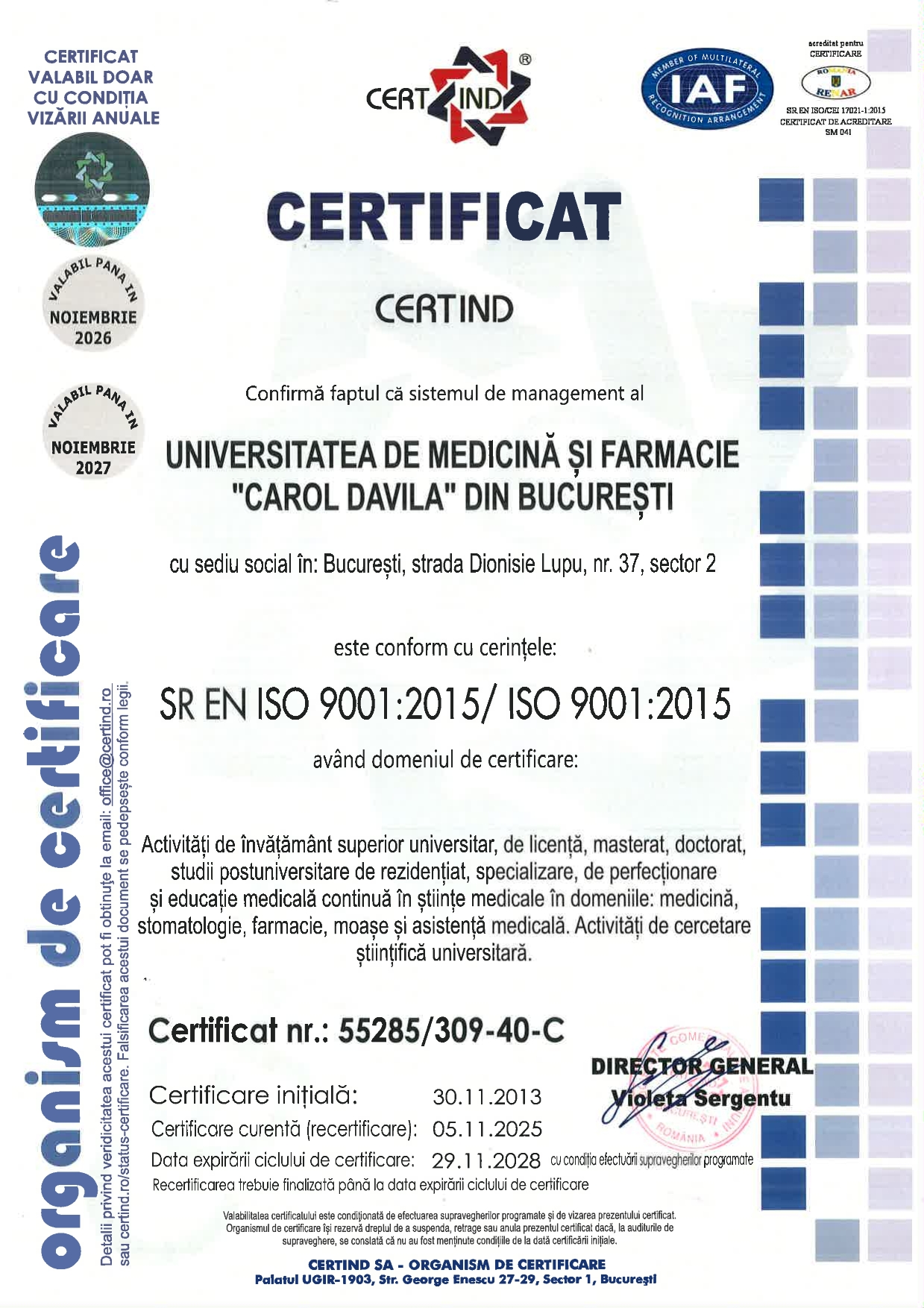Nr contract: 114/1.07.2014
Coordonator : UNIVERSIATEA DE MEDICINA SI FARMACIE CAROL DAVILA BUCURESTI
Director proiect : Prof dr Liliana Voinea
Parteneri :
INSTITUTUL NATIONAL DE CERCETARE – DEZVOLTARE PENTRU METALE NEFEROASE SI RARE – IMNR;
UNIVERSITATEA POLITEHNICA DIN BUCURESTI;
INSTITUTUL DE BIOLOGIE SI PATOLOGIE CELULARA ,,NICOLAE SIMIONESCU”;
SITEX 45 SRL
Valoarea proiectului :1.250.000 lei
Data inceperii proiectului :1/07/2014
Data terminarii proiectului: 30/06/2016
Durata proiectului :24 luni
Propunerea proiectului
Scopul proiectului este reprezentat de realizarea unui nou implant ocular nanocompozit bazat pe hidroxiapatita si poliuretan, cunoscut fiind faptul ca implantele oculare actuale sunt realizate din hidroxiapatita coralina (naturala) iar poliuretanul a fost propus spre utilizare ca si cornee artificiala la iepuri. Proiectul isi propune realizarea unei matrici compozite cu o viteza de proliferare vasculara mare in interiorul implantului, permitand astfel scurtarea timpului de asteptare pana la protezarea finala dar si prezervarea integritatii functionale a orbitei si pleoapelor.
Studiul isi propune realizarea unor studii comparative pe animale intre implante deja disponibile pe piata medicala si implantul nanocompozit de hidroxiapatita si poliuretan fiind luate in considerare aspectele impuse de Comisia de Etica. Dezvoltarea noului implant oculat nanocompozit reprezinta baza fabricarii pe scara larga a unei proteze oculare care sa inlocuiasca continutul sacului sclera in momentul eviscerarii globului ocular datorate diverselor afectiuni oftalmologice. Se vor realiza studii privind influenta materialelor nanocompozite obtinute asupra tesuturilor inconjuratoare, biocompatibilitateaacestora si viteza de proliferare a tesuturilor in interiorul implantului. Materialul nanocompozit de hidroxiapatita si poliuretan va fi sintetizat prin metoda hidrotermala intr-o singura etapa, la temperatura sczuta (<100 grade) dar persiune crescuta (>200atm). Din stadiul cercetarii actuale reiese ca nu s-au mai folosit materiale hibride nanocompozite pentru implane oculare pana in prezent. Impactul structural dar si macroscopic va fi evaluat prin cercetari imagistice (CT) si prin reconstructie CAD-CAM se vor pune bazele realizarii de implante inalt personalizate.
Project proposal
The proposed project aims to design a new type of orbital implant made of nanocomposite material based on hydroxyapatite and polyurethane, knowing that the commercially available eye implants made of natural hydroxyapatite and polyurethane was previously used as artificial cornea for rabbit eyes. It is expected to obtain a composite scaffold with a higher rate of vascular proliferation within the implant that allows shortening of the waiting time for final prosthesis and preserving the integrity of the eyelid.
This project envisages comparative studies on animals between the newly created implant and already existing ones on the market, taking into account ethical issues. Development of a conceptually new implant for orbital prosthesis is based on the fabrication of an implant for the replacement of ocular the content in the scleral sac obtained through removal of the content of the eye by evisceration.
The influence of the composition and structure of the newly proposed composite material for orbital prosthesis on biocompatibility and growth of the proliferation rate will be studied. Nanocomposite material based on polyurethane and hydroxyapatite with controlled structure and porosity will be synthesized by hydrothermal method, in a single step process, at high pressures (> 200 atm) and low temperatures (< 100 0C). Based on previous experience of the research group in the field of hybrid organic-inorganic nanomaterials prepared in high pressure conditions, it is expected to obtain strong interactions between the two components of the composite material, leading to a compositionally homogeneous and stable nanocomposite in the biological medium without decomposing or releasing toxic secondary products in the surrounding tissue. To the best of our knowledge, it is the first time when this type of nanocomposite material is used for the fabrication of an orbital eye implant.
Macroscopic and computer tomographic researches regarding the short term impact of implantation and prosthesis upon the eye socket will be also performed. Resulted data will be essential for the future morphoclinical correlations focusing primarily on the synthesis of biomaterials with a high rate of proliferation and healing. The CAD-CAM method will be developed as a rapid method to create the new customised implant.



